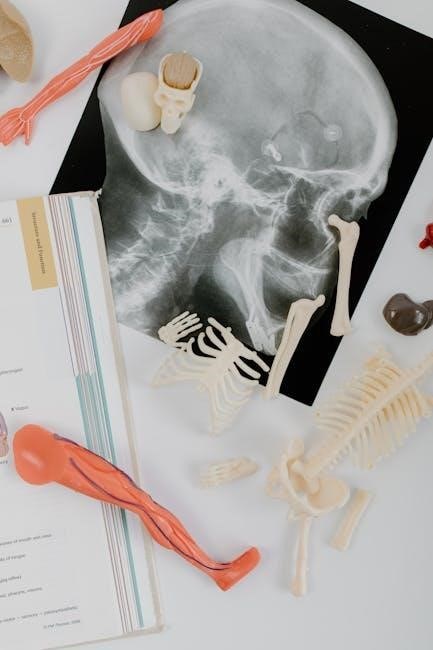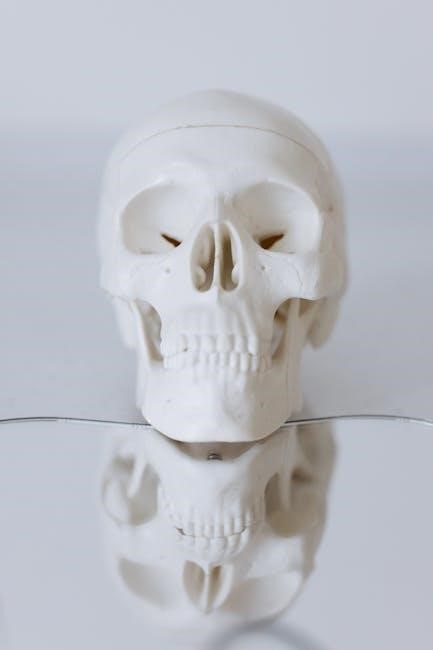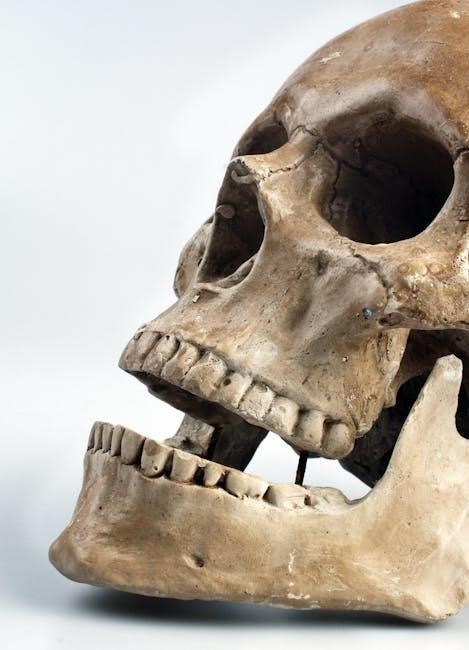Guided Tissue Regeneration (GTR) and bone grafting are surgical procedures used to restore lost bone and tissue, essential for dental implants. GTR uses membranes to regenerate periodontal structures, while bone grafting adds bone material to deficient areas. Both aim to rebuild supportive tissues but differ in approach and application, making them vital in modern dentistry for addressing periodontal disease and implant preparation.
Overview of Guided Tissue Regeneration (GTR)
Guided Tissue Regeneration (GTR) is a surgical procedure that promotes the growth of lost periodontal structures, including bone, periodontal ligament, and connective tissue. It involves placing a membrane barrier to prevent non-ossifying cells from invading the defect, allowing bone and tissue to regenerate naturally. This technique is often used to treat periodontal disease, where pockets form between teeth and gums, and to prepare the jaw for dental implants by restoring lost bone and tissue. GTR is a minimally invasive approach that supports long-term oral health and stability.
Overview of Bone Grafting
Bone grafting is a surgical procedure that involves adding bone material to areas with insufficient bone structure. It is commonly used to restore lost bone in extraction sockets or to prepare the jaw for dental implants. The graft can be autograft (from the patient), allograft (donor bone), or synthetic. After placement, the graft heals for 3 to 6 months, integrating with the existing bone. This procedure is essential for creating a stable foundation for implants and restoring oral function and aesthetics in cases of bone deficiency.

Principles of Guided Tissue Regeneration
Guided Tissue Regeneration uses barriers to prevent non-ossifying cells from entering defects, promoting bone and tissue growth in areas damaged by disease or trauma.
Role of Membranes in GTR
In GTR, membranes act as barriers, preventing unwanted cells from entering healing sites. They promote bone and tissue regeneration by protecting the defect and maintaining space for growth.
Types of Membranes Used
In GTR, membranes are categorized as non-resorbable or bioresorbable. Non-resorbable membranes, like ePTFE, require removal after healing, while bioresorbable membranes, such as collagen or synthetic polymers, degrade naturally. Both types act as barriers to prevent non-ossifying cells from invading the defect, facilitating selective tissue regeneration. Their design and material properties influence healing outcomes, with resorbable membranes offering convenience and reduced surgical steps.
Biological Mechanisms Behind GTR
Guided Tissue Regeneration (GTR) relies on preventing non-ossifying cells from invading defects, allowing bone and periodontal ligament cells to populate the area. Membranes act as barriers, promoting selective tissue growth. Growth factors and osteoblasts stimulate bone formation, while the membrane ensures a protected environment for healing. This biological process enables the regeneration of lost periodontal structures, fostering a conducive environment for dental implants and restoring functional tissue and bone.

Principles of Bone Grafting
Bone grafting is a surgical method that introduces bone graft materials to restore density and support. It requires 3–6 months for healing before dental implants can be placed.
Types of Bone Grafts
Bone grafts are categorized into four main types: autografts, taken from the patient; allografts, from donors; xenografts, from animals; and alloplasts, synthetic materials. Each type has unique benefits and applications, such as autografts being the most biocompatible, while alloplasts offer a convenient alternative without the need for additional surgeries. These options allow for tailored approaches to address different bone deficiencies and patient needs, ensuring the best possible outcomes for dental implant success and tissue regeneration.
Healing Process After Bone Grafting
The healing process after bone grafting typically takes 3 to 6 months, though it can extend up to a year for complete integration. Initially, swelling and bruising are common, subsiding within a week. Patients must avoid disturbing the graft site to ensure proper healing. Follow-up appointments monitor progress, and stitches are removed after 1-2 weeks. The graft gradually integrates with the existing bone, forming a stable base for dental implants. Proper post-operative care is crucial to prevent complications and ensure successful bone regeneration.
Materials Used in Bone Grafting
Bone grafting utilizes various materials to promote healing and regeneration. Autografts, taken from the patient’s own body, are considered the gold standard due to their high success rate. Allografts, derived from donor bone, are a common alternative. Xenografts, sourced from animals, and synthetic grafts, made from materials like hydroxyapatite or calcium phosphate, are also used. Additionally, growth factor-enhanced grafts stimulate bone regeneration. Each material has unique properties, and the choice depends on the patient’s needs, graft availability, and the surgeon’s preference.

Indications and Uses
Both GTR and bone grafting are used to restore bone and tissue, primarily for dental implants and treating periodontal disease, ensuring proper healing and stability effectively.
Common Applications of GTR
Guided Tissue Regeneration (GTR) is primarily used to address periodontal defects, such as deep pockets and bone loss around teeth. It is effective in regenerating the periodontal ligament, cementum, and bone. GTR is also utilized to prepare the jaw for dental implants by creating a stable environment for osseointegration. Additionally, it helps in stabilizing teeth threatened by periodontal disease, ensuring long-term dental health and functionality. This procedure is particularly beneficial for patients with severe periodontal damage who require targeted tissue repair.
Common Applications of Bone Grafting
Bone grafting is widely used to restore bone loss in areas where teeth have been extracted, ensuring proper healing and preparing the site for dental implants. It is also applied to repair defects caused by trauma, infection, or congenital conditions. Additionally, bone grafting is used to augment the jawbone in cases of insufficient density, making it suitable for implant placement. This procedure is essential for rebuilding structural support, promoting osseointegration, and restoring functional and aesthetic outcomes in patients with significant bone deficiencies.

Effectiveness and Success Rates
Both GTR and bone grafting demonstrate high success rates, with proper patient selection and care. Success depends on factors like healing time, membrane integrity, and surgical technique.
Success Rates of GTR
Guided Tissue Regeneration (GTR) has shown high success rates, with clinical studies indicating significant bone and tissue growth. Success rates often exceed 80-90% when proper techniques and materials are used. The procedure’s effectiveness depends on factors like membrane type, patient health, and surgical precision. Healing periods vary, but most patients achieve desired outcomes within 6-9 months. Advances in membrane technology and growth factors have further enhanced GTR’s success, making it a reliable option for periodontal regeneration and implant preparation.
Success Rates of Bone Grafting
Bone grafting demonstrates high success rates, typically ranging from 85% to 95%, depending on the graft type and patient health. Autografts (patient’s own bone) generally yield higher success rates compared to allografts or xenografts. The procedure’s effectiveness is influenced by factors such as graft material, surgical technique, and post-operative care. Healing periods vary, with initial integration often occurring within 3-6 months, followed by an additional 4-6 months before dental implants can be placed. Advances in grafting materials and techniques have significantly improved outcomes, making bone grafting a reliable option for dental reconstruction.

Procedure Comparison
Guided tissue regeneration (GTR) involves placing membranes to regenerate bone and gum tissue, while bone grafting adds bone material to deficient areas, both aiming to support dental implants effectively.
Step-by-Step GTR Procedure
The procedure begins with a local anesthetic to numb the area. An incision is made to access the affected site, and diseased tissue is removed. A biocompatible membrane is then placed over the defect to guide regeneration. The gum tissue is sutured back in place, securing the membrane. Healing occurs over 4-6 months, during which the membrane prevents unwanted tissue growth. After healing, the membrane may be removed, and the site is prepared for dental implants. Regular follow-ups ensure proper regeneration and readiness for further treatment.
Step-by-Step Bone Grafting Procedure
The procedure begins with a consultation to assess the bone deficiency. Under local anesthesia, an incision is made to expose the graft site. Bone graft material, either autograft, allograft, or synthetic, is placed in the deficient area. The graft is secured and covered with a membrane to promote healing. The incision is closed with sutures, and the site is allowed to heal for 3-6 months. Post-operative care includes avoiding pressure on the graft site and following a soft-food diet to ensure proper integration and bone regeneration before dental implant placement.

Post-Operative Care and Recovery
Post-operative care involves a soft-food diet, avoiding strenuous activities, and maintaining oral hygiene. Patients should follow specific instructions and attend follow-up appointments for optimal healing.
Recovery After GTR
Recovery after Guided Tissue Regeneration varies, with most patients experiencing mild discomfort or swelling. Healing typically takes several months, during which the membrane protects the regenerating tissue. Patients are advised to stick to a soft-food diet, avoid vigorous brushing near the site, and attend follow-up appointments. Proper care ensures the membrane remains intact, promoting successful tissue regeneration without complications.
Recovery After Bone Grafting
The recovery period for bone grafting typically lasts several months, with initial healing taking 3 to 6 months. Patients may experience swelling, bruising, and discomfort, managed with pain medication. A soft-food diet is recommended to avoid disrupting the graft site. After the membrane is removed or falls out, an additional 4-6 months of healing is required before dental implants can be placed. Proper post-operative care, including gentle oral hygiene, is crucial for successful bone integration and long-term results.

Risks and Complications
Both GTR and bone grafting carry risks, including infection, membrane exposure, and graft failure. Proper post-operative care and expert surgical technique are essential to minimize complications.
Potential Risks of GTR
Guided Tissue Regeneration (GTR) carries risks such as infection, swelling, and membrane exposure. Patients may experience bruising or pain post-procedure. In rare cases, graft failure can occur if the membrane is dislodged or infected. Proper post-operative care, including adherence to dietary restrictions and hygiene practices, is crucial to minimize these complications. Additionally, smoking or poor oral health can increase the likelihood of adverse outcomes. Regular follow-ups with a periodontist are essential to monitor healing and address any emerging issues promptly.
Potential Risks of Bone Grafting
Bone grafting carries risks such as swelling, bruising, and pain at the surgical site. Infection is a possible complication, especially if proper post-operative care is not followed. Additionally, the graft may fail to integrate with the existing bone, leading to inadequate healing. Smoking or poor oral health can exacerbate these risks. Patients may also experience temporary numbness or tingling near the graft site. In rare cases, the bone graft may resorb over time, reducing its effectiveness. Regular follow-ups with a dentist or periodontist are essential to monitor the healing process and address any complications promptly.

Cost Considerations
Bone grafting and guided tissue regeneration costs vary widely based on the procedure’s complexity, materials used, and surgeon expertise. Bone grafting can range from $500 to $2,000 per graft, while GTR may add additional expenses for membranes and growth factors, potentially increasing the total cost to $1,000 or more.
Cost of GTR
The cost of Guided Tissue Regeneration (GTR) varies based on the complexity of the procedure, materials, and surgeon expertise. On average, GTR can range from $500 to $2,000, depending on the type of membranes or growth factors used. In some cases, when combined with bone grafting, the total cost may exceed $1,000. Insurance coverage is limited, making it an out-of-pocket expense for many patients. The expertise of the periodontist or surgeon also influences the final cost, as does the location and clinic facilities.
Cost of Bone Grafting
Bone grafting costs typically range from $300 to $1,200 per procedure, depending on the type of graft and complexity. Autografts, using the patient’s own bone, are generally more expensive than allografts or xenografts; Additional fees for surgeon expertise, facility costs, and post-operative care can increase the total expense. Insurance coverage varies, and in many cases, bone grafting is considered elective, making it an out-of-pocket cost. The final price may also depend on the size of the graft and whether it is combined with other procedures like dental implant placement.

Future of Guided Tissue Regeneration and Bone Grafting
Advancements in bioactive materials, 3D printing, and stem cell therapy are reshaping GTR and bone grafting, offering more efficient and personalized treatments for tissue and bone regeneration.
Advancements in GTR
Recent advancements in GTR include the development of bioactive membranes, which release growth factors to enhance tissue regeneration. Innovations in 3D printing enable customized membrane designs, improving precision and outcomes. Researchers are also exploring the use of stem cells and platelet-rich plasma to accelerate healing and tissue growth. These advancements aim to make GTR more predictable, minimally invasive, and patient-specific, offering improved results for periodontal and implant-related treatments. Such innovations highlight the evolving potential of GTR in modern dental regenerative therapies.
Advancements in Bone Grafting
Recent advancements in bone grafting include the use of bioactive materials and growth factor-impregnated grafts to enhance bone regeneration. 3D-printed custom grafts are now being utilized for precise fits in complex defects. Additionally, recombinant bone morphogenetic proteins (BMPs) and stem cell therapies are being explored to accelerate healing and improve graft integration. These innovations aim to reduce recovery times, minimize donor site morbidity, and improve the predictability of bone grafting procedures, offering patients more effective and personalized treatment options for dental and orthopedic applications.